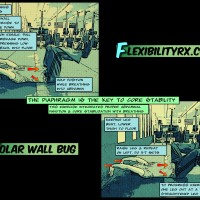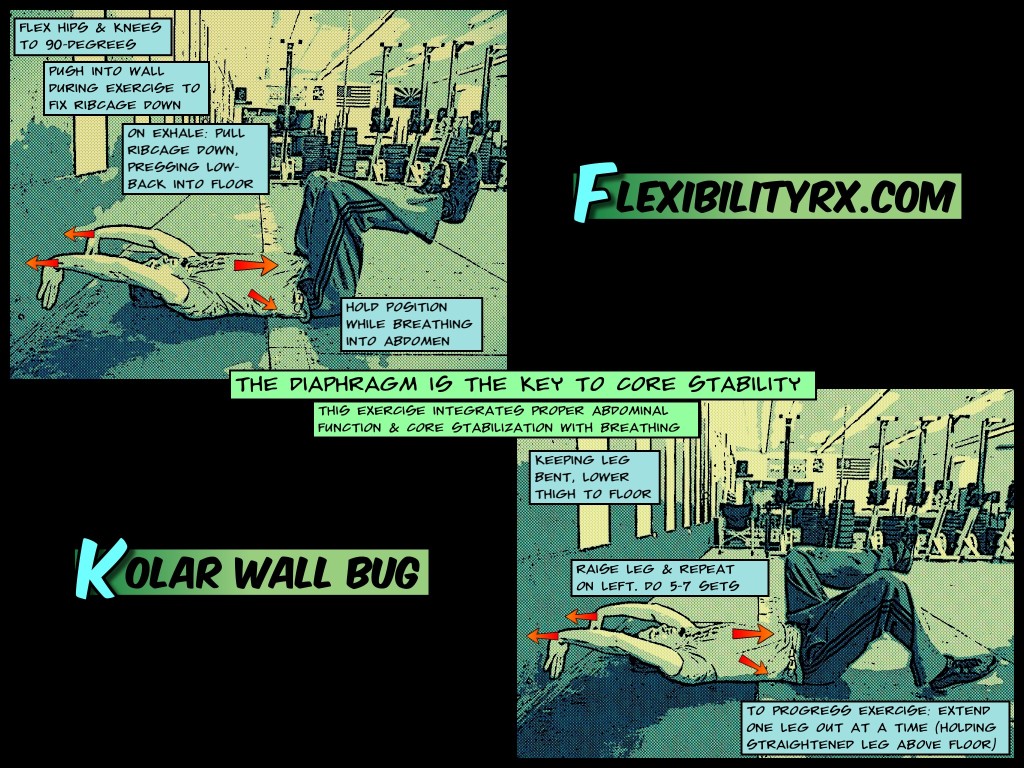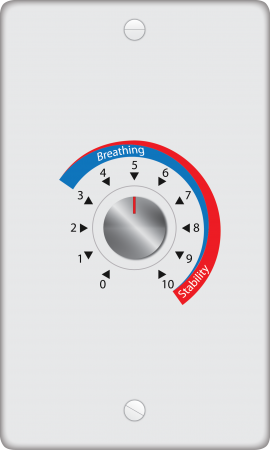
Kolar Wall Bug
The Kolar Wall Bug is a breathing and core stabilization exercise that is great pre-workout for abdominal activation. Athletes that over-extend their low-back during squats and deadlifts can prevent lumbar hyperextension by learning to breathe effectively and integrate breathing with core stabilization.
Proper breathing is the key to core stabilization. Breathing affects low-back stabilization, thoracic flexibility, scapular stability, and shoulder internal/external rotation.
Dysfunctional Breathing
Reduces the amount of weight you can squat or deadlift
Limits thoracic flexibility needed for the front rack position
Destabilizes the scapula restricting shoulder flexion
Impairs shoulder rotation needed for the snatch and overhead squat
Diaphragm Function
On the inhale the diaphragm contracts pushing down into the abdomen and out into the lower ribcage. This contraction creates an eccentric contraction of the abdominal wall and is countered by resistance from the pelvic floor below and the spinal extensors in back. When the diaphragm properly contracts the resistance from the abdominals, pelvic floor, and lumbar extensors creates proper intra-abdominal pressure and fully stabilizes the spine.

Many athletes have dysfunctional breathing patterns – including neck and chest breathing. When the diaphragm doesn’t fully descend and expand laterally into the sides of the ribs the muscles that oppose the diaphragm are not engaged properly to create intra-abdominal pressure. Belly breathing that lacks a lateral expansion of the ribcage is also dysfunction – as the diaphragm needs to expand the abdomen in front and into the sides.
This proper diaphragm contraction and intra-abdominal pressure is what stabilizes the lower lumbar spine (L4/5) where loading is most prominent during squats and deadllifts.
“When all muscles at a joint stiffen together a “super stiffness” phenomenon generally occurs. The total stiffness at a joint suddenly becomes more than the sum of individual muscle stiffnesses. Consider the abdominal wall in creating “core stability”. Rectus abdominis, external and internal oblique and transverse abdominis appear to bind together when all are active to create a super stiffness higher than the sum of each individual muscle.” – Stuart McGill
Dual Functions of the Diaphragm
The diaphragm has two roles – breathing and core stabilization. During low level activities like walking the diaphragm is used primarily for breathing. At the other end of the spectrum, holding one’s breathe during a one rep max effort, is utilizing the diaphragm strictly for stabilization. Many exercises in the gym recruit the diaphragm for both breathing and stabilization simultaneously. Hans Lindgren (DNS practitioner) explains in this great blog, that the diaphragm functions like a dial – athletes can tune it’s amount of effort for each responsibility.
“Controlling the diaphragm’s dual functions and adjusting its activity levels accurately requires practice.” – Hans Lindgren
The Kolar Wall Bug allows an athlete to practice diaphragmatic breathing with a low-level stabilization change. Pushing into the wall makes it easier to fix the ribcage down into a good position, flattening the back against the floor, as the abdominals control the hips and low-back during the leg movement.
Heavier Squats and Deadlifts
The wall bug can be used to activate the abdominals to decrease anterior pelvic tilt and prevent lumbar hyperextension – setting up better positions for lifts like squats and deadlifts.
Thoracic Extension
By improving pelvic tilt, core stability, and spinal alignment athletes will find it easier to maintain extension through the thoracic spine, which is needed for scapular stability.
Scapular Stability
A proper diaphragm contraction – lateral expansion into the ribcage, creates a ‘fixed point’ on the ribs for serratus anterior to support the scapula. Improving the alignment of the shoulder blade, internal and external rotation also improves – for a better front-rack position and bar path in overhead lifts.
The Deep Front Line
The deep hip flexor (psoas) is part of what Tom Myers calls the, “Deep Front Line”. Looking at the fascial anatomy of this line of connective tissue it is evident that the psoas and diaphragm are closely connected via the connective tissue. What this means is that a tight psoas not only contributes to poor pelvic and low-back alignment, but directly restricts diaphragm function. Use the wall bug with this hip-flexor stretch pre-workout.
– Kevin Kula, “The Flexibility Coach” – Creator of FlexibilityRx™
Tags: ab exercises, abdominal activation, butt-wink, core activation, core stability, dead bug, diaphragmatic breathing, DNS, dynamic neuromuscular stabilization, fixing the butt-wink, kolar wall bug, rehabpps, stability for the squat


Leave A Reply (No comments so far)
You must be logged in to post a comment.
No comments yet